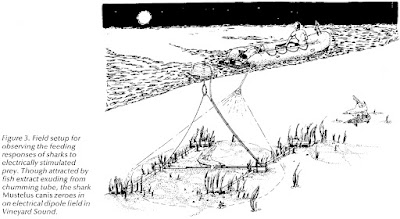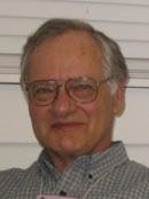I recently read
Gerald Pollack’s book
Cells, Gels and the Engines of Life: A New, Unifying Approach to Cell Function. I’ve always taken a simple, physicist’s view of a
cell: salt water inside, salt water outside, with a
membrane between; the membrane being where all the action is. Pollack’s perspective is entirely different, and challenges the standard dogma in cell biology. He focuses on the how the inside of a cell resembles a
gel.
The gel-like nature of the cytoplasm forms the foundation of this book. Biologists acknowledge the cytoplasm’s gel-like character, but textbooks nevertheless build on aqueous solution behavior. A gel is quite different from an aqueous solution—it is a matrix of polymers to which water and ions cling. That’s why gelatin desserts retain water, and why a cracked egg feels gooey.
The concept of a gel-like cytoplasm turns out to be replete with power. It accounts for the characteristic partitioning of ions between the inside and outside of the cell... It also explains the cell’s electrical potential: potentials of substantial magnitude can be measured in gels as well as in demembranated cells... Thus, the gel-like character of the cytoplasm accounts for the basic features of cell biophysics.
What do I think of Pollack’s radical attitude toward biology? I’m not sold on his ideas, but his book certainly made me rethink my fundamental assumptions about biology in general, and electrophysiology in particular.
Pumps and Channels
In Intermediate Physics for Medicine and Biology, Russ Hobbie and I describe the standard view of how ion gradients across the cell membrane are created by a pump (page 155).
To maintain the ion concentrations a membrane protein called the sodium-potassium pump uses metabolic energy to pump potassium into the cell and sodium out.
On page 193, we discuss
ion channels.
Selective ion channels are responsible for the initiation and propagation of the action potentials.
Pollack doesn’t believe pumps and channels are important. How can this be? What about
patch clamping? Section 9.7 of
IPMB talks this revolutionary technique (page 251).
The next big advance was patch-clamp recording (Neher and Sakmann 1976). Micropipettes were sealed against a cell membrane that had been cleaned of connective tissue by treatment with enzymes. A very-high-resistance seal resulted [(2–3)×107 Ω] that allowed one to see the opening and closing of individual channels.
Pollack says
The existence of single ion channels appeared to be confirmed by ground-breaking experiments using the patch-clamp technique… This dazzling result has so revolutionized the field of membrane electrophysiology that the originators of this technique, Erwin Neher and Bert Sakmann, were awarded the Nobel Prize. The observation of discrete events would seem to confirm beyond doubt that the ions flow through discrete channels.
Results from the laboratory of Fred Sachs, on the other hand, make one wonder. Sachs found that when the patch of membrane was replaced by a patch of silicon rubber, the discrete currents did not disappear… they remained essentially indistinguishable from those measured when the membrane was present.
Yikes! Pollack’s arguments against pumps don’t terrify me quite as much.
Pumping faces obstacles of space and energy. The membrane’s size is fixed but the number of pumps will inevitably continue to grow. At some stage the demand for space could exceed the supply, and what then? Pumping also requires energy. The Na/K pump alone is estimated to consume an appreciable fraction of the cell’s energy supply, and that pump is one of very many, including those in internal membranes. How is the cell to cope with the associated energy requirement?
Membranes
Pollack goes on to renounce the importance of the cell membrane.
Continuing to move boldly, we took it upon ourselves in this chapter to reconsider the notion of the continuous ion barrier [the membrane]. If the barrier were continuous, we reasoned, violating its continuity by tearing large holes should allow ions to surge across the cell boundary and solutes to leak out, dramatically altering the cell’s makeup, shutting down cell function, and eventually killing the cell.
But that did not happen. Whether created by shoving a micropipette into the cell, plucking a patch from the membrane, riddling the membrane with an electrical barrage [electroporation], or slicing the cell into two, the wounds seemed to matter little; the cell could often continue to function as though there had been no violation. It was as though function could be sustained by the cytoplasm alone.
The Resting Transmembrane Potential
Russ and I explain the resting potential of a cell in the conventional way: the membrane is selectively permeable to potassium, and the potassium ion concentration is higher inside the cell than outside. The concentrations will be in equilibrium when the resting potential is negative, with a magnitude given by the
Nernst equation. Pollack’s explanation is completely different, and focuses on the structuring of water near the hydrophilic surface of proteins.
Cell water excludes ions because it is structured. Exclusion is more pronounced for sodium than for potassium because sodium’s hydration shell is larger and hence more difficult to accommodate in the structured water lattice. Thus, intracellular sodium concentration remains low, whereas potassium can partition more easily into the cytoplasm.
No pumps, no channels, no membranes, no Nernst equation, and no metabolic
ATP. Just water.
The Action Potential
Pollack’s story may sound plausible, if not convincing, so far, but what about the action potential? This is where gels come in the forefront of the story. According to Pollack, the cytoplasm is like a gel that can undergo a polymer-gel phase transition. Normally the cytoplasmic polymers are cross linked by
calcium, allowing in little water. If the calcium is not there to do the cross-linking, water gets sucked in, loosening the structure.
A plausible way in which the action potential could be initiated, then, is by replacing calcium with a monovalent [singly charged ion such as sodium or potassium]. Classically, sodium is thought to enter the cytoplasm through a localized, receptor-mediated permeability increase. In the proposed [Pollack’s] model, sodium ions flow into the peripheral cytoskeleton and begin displacing calcium. Replacement loosens the network, enabling it to adsorb water and expand. As it expands, permeability is increased, allowing for more sodium entry, further Ca displacement, additional expansion, etc.—like ripping open a zipper.
It sure doesn’t sound much like Hodgkin and Huxley.
Internal Perfusion
For a moment, I thought I had a devastating counter-example that would demolish Pollack’s theory.
As mentioned before in this blog, you can squeeze the cytoplasm out of a
squid giant axon and replace it by salt water, and the axon still works. But Pollack must have seen me coming; he shot down my counter-example in advance.
Lying just inside the cell membrane is a dense polymer-gel matrix known as the peripheral cytoskeleton… The presence of such a matrix had been unknown during the Hodgkin-Huxley era when experimental axons were routinely “rolled” to extrude the cytoplasm and presumably leave only the membrane. What in fact remains is the combination of membrane plus contiguous cytoskeleton.
Conclusion
I have only begun to cover the ideas discussed in
Cells, Gels and the Engines of Life. Pollack provides us with a wonderfully written, beautifully illustrated, carefully argued, and well cited alternative view of biology. It was a joy to read, but I remain skeptical. I can think of many arguments in support of the “standard model” of cell physiology that Pollack doesn’t address. My “salt water inside, salt water outside” assumption may be too simplistic, and Pollack’s book is useful for pointing out its many limitations, but Pollack’s ideas have limitations too.
Cells, Gels and the Engines of Life is an interesting read, but think long and hard before you start believing it.















